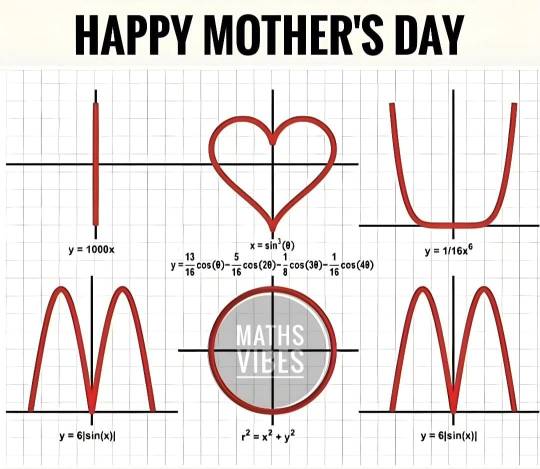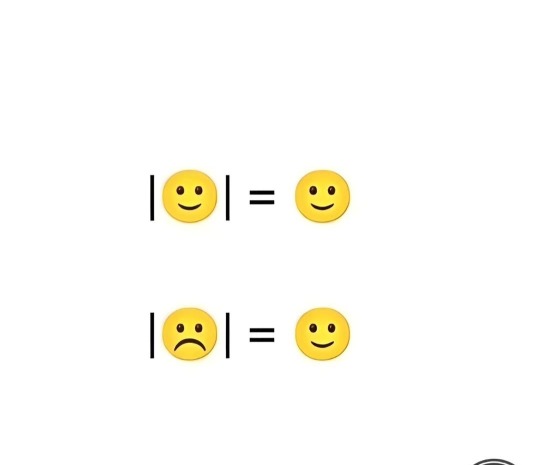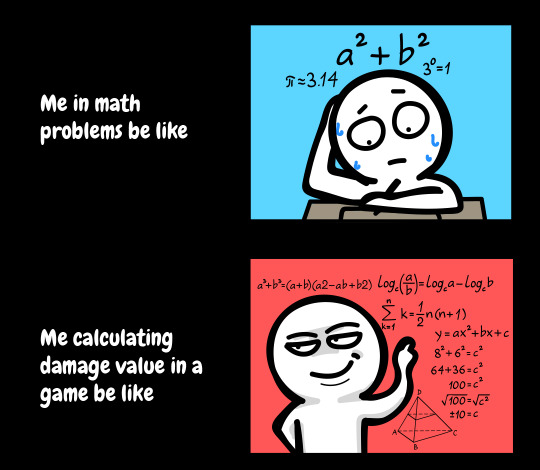Hey there! I'm Ms. Annaelle, the maths educator that has a mission to make numbers not just comprehensible, but downright exciting!
Don't wanna be here? Send us removal request.
Text
Math Tips 😋📚

3 notes
·
View notes
Text
Personal Reflection on the Desmos Graphing Calculator 📊✨
As a tool for teaching and learning mathematics, the Desmos graphing calculator represents a remarkable advancement in educational technology. Its intuitive interface and powerful capabilities make complex mathematical concepts more accessible and visually engaging. However, as with any educational tool, there are both benefits and potential drawbacks. One significant disadvantage that stands out to me is the risk of reducing students' problem-solving skills. 🤔
Problem-solving is at the heart of mathematics education. It is through grappling with challenging problems, making mistakes, and finding solutions that students develop critical thinking and analytical skills. These skills are not only vital for academic success but also for real-world applications where solutions are rarely straightforward or provided by a calculator. 🧠💡
Desmos, while incredibly useful for visualizing functions and solving equations quickly, can sometimes shortcut this crucial learning process. When students rely heavily on Desmos to find answers, they may miss out on the valuable experience of working through problems step-by-step. The calculator provides immediate solutions, but without the struggle of manual calculation and logical deduction, students may not fully understand the underlying principles that lead to those solutions. 🚀🔢
For example, in substituting numbers into the expression 3𝑥^2+2𝑦−5𝑧, Desmos can instantly show the result for given values of 𝑥, 𝑦, and 𝑧. Suppose we have 𝑥=2; 𝑦=3; and 𝑧=4. Desmos will quickly compute the value as 1. However, without manually performing the steps—calculating 3⋅ (2^2), adding 2 ⋅3, and subtracting 5 ⋅4—students might not appreciate the nuances of each calculation. They lose the opportunity to strengthen their arithmetic and algebraic manipulation skills and deepen their conceptual understanding. 🔍✍️
Moreover, problem-solving often involves more than just finding the correct answer; it involves reasoning, strategizing, and sometimes approaching a problem from multiple angles. Desmos can inadvertently create a mindset where students expect immediate results, potentially diminishing their patience and perseverance when faced with complex problems that require sustained effort and creative thinking. 🧩🕵️♂️
This is not to say that Desmos does not have a place in the classroom. On the contrary, it is a powerful tool that can enhance learning when used appropriately. Teachers can leverage its capabilities to demonstrate concepts, visualize problems, and check work. An added advantage is that it encourages a balance between manual calculations and the use of Desmos. Use the software for complex graphing and visualization while ensuring students practice basic arithmetic and algebra manually. This balanced approach ensures that students develop strong foundational skills while benefiting from technological tools for more advanced concepts. ⚖️🔧
To mitigate this disadvantage, educators can adopt strategies that encourage the development of problem-solving skills alongside the use of Desmos. For instance, teachers can assign problems that require manual calculations first, followed by using Desmos to verify answers. They can also create activities that require students to explain their reasoning and the steps they took to reach a solution, ensuring that the process is valued as much as the result. 📝👩🏫
In conclusion, while the Desmos graphing calculator offers significant educational benefits, it is essential to be mindful of its impact on students' problem-solving skills. By fostering a balanced approach that integrates technology with traditional problem-solving techniques, we can help students develop the robust analytical and critical thinking skills they need to succeed in mathematics and beyond. 🌟📐
2 notes
·
View notes
Text
Hello friends, here is a tutorial I created to give you an idea of how to use the simulation software.
2 notes
·
View notes
Text
Did You Know the Math Simulation Software Desmos Graphing Calculator? 📊✨
Mathematics can be a daunting subject for many, but thanks to the incredible Desmos Graphing Calculator, the world of numbers, equations, and graphs has become more accessible and engaging than ever before! 🌟 Whether you’re a student, teacher, or math enthusiast, Desmos offers a fantastic tool that brings equations to life in a visually stunning way. Let’s dive into what makes this graphing calculator so special! 🚀
A User-Friendly Interface 🖥️😊
One of the first things you’ll notice about the Desmos Graphing Calculator is its clean and intuitive interface. You don’t need to be a tech genius to start plotting graphs. The layout is simple, making it easy for users of all ages to navigate through the various features. Just type in your equation, and watch as it instantly appears on the graph! ✍️➡️📈
Dynamic and Interactive Graphs 📉✨
Gone are the days of static and boring graphs. With Desmos, you can interact with your graphs in real-time. Want to see how a parabola shifts when you change the coefficient? Or how a sine wave stretches with different frequencies? Desmos lets you adjust parameters on the fly, showing you the immediate impact on the graph. It’s like having a math laboratory right at your fingertips! 🧪🔍
Supports a Wide Range of Functions 📚🔢
From basic algebraic equations to complex calculus functions, Desmos has got you covered. It supports a wide range of mathematical functions including trigonometry, logarithms, and even piecewise functions. This versatility makes it a valuable tool for both high school and college-level math. 📏🔍
Perfect for Teachers and Students 🧑🏫👩🎓
For educators, Desmos is a game-changer in the classroom. It allows teachers to create interactive lessons that can be shared with students, making learning more engaging. Students can experiment with equations and visualize concepts in a way that textbooks simply can’t match. Plus, the Desmos community is a treasure trove of shared graphs and activities, perfect for enhancing the learning experience. 📚📝
Accessibility and Collaboration 🤝🌍
Desmos is committed to accessibility. It’s available on any device with a web browser, and it’s free! Plus, with the collaborative features, students and teachers can work together on projects, making it a fantastic tool for group studies and classroom activities. The ability to save and share graphs means you can continue learning and exploring, anytime and anywhere. 🌐💡
Beyond Math: Creative Uses ��🌈
While Desmos is a powerhouse for mathematical graphing, its utility doesn’t stop there. Many users have found creative ways to use Desmos for art and design. By manipulating equations and parameters, you can create beautiful and intricate patterns. Who knew math could be so artistic? 🎨🖌️
Conclusion: Math Made Magical ✨🔮
The Desmos Graphing Calculator is more than just a tool; it’s a gateway to understanding and appreciating the beauty of mathematics. Its user-friendly interface, dynamic graphing capabilities, and vast range of functions make it an indispensable resource for anyone interested in math. Whether you’re solving complex problems or simply exploring the world of equations, Desmos makes the journey enjoyable and enlightening. So why wait? Dive into the world of Desmos and let the magic of math unfold before your eyes! 🌟📐🧮
2 notes
·
View notes
Text
My Personal Reflection on GeoGebra
Hey everyone! Today, I want to share my thoughts on using GeoGebra, the amazing simulation software that has been a game-changer in my math studies. 📚✨
The Good Stuff 🌟
GeoGebra is seriously awesome for visualizing complex math concepts. Whether it’s geometry, algebra, or calculus, this tool makes everything so much easier to understand. You can see graphs, manipulate shapes, and perform calculations with just a few clicks. It’s like having a math playground right at your fingertips! 🖥️📊
The Flip Side 😕
But here’s where things get tricky. While GeoGebra is fantastic for learning, it has its downsides too. The biggest issue is that standardized tests and many classroom assessments don’t allow the use of such software. 📝🚫
This means we need to be good at manual calculations and understand the concepts deeply, without relying on technology. If we get too used to letting GeoGebra do all the work, we might find ourselves struggling during these tests. 📏🤔
Finding the Balance ⚖️
It’s all about balance, really. GeoGebra is a powerful tool that can enhance our learning, but we shouldn’t let it become a crutch. We need to make sure we’re equally comfortable doing math the old-fashioned way, with a pencil and paper. 🖊️📐
Final Thoughts 💭
In conclusion, GeoGebra is like a double-edged sword. It can boost our understanding and make learning math fun, but it also has the potential to make us reliant on technology. Let’s use it wisely and ensure we’re always prepared for those tech-free tests! 💪📘
Have any of you used GeoGebra? What are your thoughts on balancing tech and traditional learning methods? Drop your comments below! ⬇️💬
3 notes
·
View notes
Text
Here is a tutorial about how to use GeoGebra to calculate the L.C.M of numbers.
2 notes
·
View notes
Text
Did You Know the Math Simulation Software GeoGebra? 🎓🧮
In the realm of educational technology, few tools have revolutionized the way we teach and learn mathematics as profoundly as GeoGebra. This dynamic software seamlessly blends geometry, algebra, calculus, and statistics, offering a versatile platform for students and educators alike. Whether you're a teacher aiming to bring mathematical concepts to life or a student looking to explore the depths of math, GeoGebra has something to offer.
What is GeoGebra? 🤔
GeoGebra is an interactive mathematics software designed to make learning and teaching math more engaging and effective. It's a powerful tool that integrates various branches of mathematics into a single platform, providing users with a comprehensive suite of tools to explore mathematical concepts visually and interactively.
Key Features of GeoGebra 🌟
Interactive Geometry: With GeoGebra, you can create constructions and models using points, vectors, segments, lines, polygons, and conic sections. The dynamic nature of these objects allows for real-time manipulation, making abstract concepts tangible and easier to understand.
Algebraic Integration: Directly input equations and coordinates to see their graphical representations. GeoGebra links algebraic and geometric views, helping users see the relationships between different mathematical expressions.
Calculus Tools: Explore derivatives, integrals, and functions with ease. GeoGebra's calculus tools are designed to help users visualize and understand these complex concepts.
Statistics and Probability: Create graphs of statistical data, calculate probabilities, and visualize distributions. These features make it easier to teach and learn statistical concepts.
3D Graphics: GeoGebra’s 3D capabilities allow for the creation and manipulation of three-dimensional graphs and shapes, providing a deeper understanding of spatial relationships.
Spreadsheet View: Handle data efficiently with the integrated spreadsheet functionality. This feature is perfect for visualizing and analyzing large data sets.
Scripting and Custom Tools: Automate tasks and create custom tools using GeoGebra’s scripting language, GGBScript, and JavaScript. This allows for tailored solutions to specific mathematical problems.
Cross-Platform Availability: GeoGebra is accessible as a web application and on various platforms including Windows, macOS, Linux, iOS, and Android, ensuring that you can use it anywhere, anytime.
Transforming Education with GeoGebra 📚💡
GeoGebra is not just a tool for solving mathematical problems; it's a bridge that connects theoretical mathematics with practical understanding. Here’s how it’s making an impact in education:
Visualization: Complex mathematical concepts become accessible through visual representation, making it easier for students to grasp abstract ideas.
Interactive Learning: Students engage more actively with math by manipulating objects and seeing the immediate effects of changes.
Immediate Feedback: GeoGebra provides instant visual feedback, aiding in the learning process and helping students correct mistakes in real-time.
Collaborative Learning: It supports group projects and resource sharing, fostering a collaborative learning environment.
Customizable Resources: Teachers can create interactive worksheets and tailor lessons to meet the needs of their students.
Why Choose GeoGebra? 🤩
User-Friendly Interface: Designed to be intuitive and easy to use, GeoGebra is suitable for all educational levels.
Rich Community and Resources: A large community of users shares resources, tutorials, and tips, making it easier to get the most out of GeoGebra.
Cost-Effective: Free to use, GeoGebra is accessible to a wide audience, ensuring that financial barriers do not hinder learning.
Versatility: Whether you’re in elementary school, university, or working on professional research, GeoGebra has tools to meet your needs.
Real-World Applications 🌍🔍
GeoGebra’s versatility extends beyond the classroom. It’s used in academic research, professional presentations, and even in real-world problem-solving scenarios. Its ability to visualize complex data and mathematical relationships makes it an invaluable tool for a wide range of applications.
Conclusion 🎉
GeoGebra is more than just software; it's a transformative educational tool that brings mathematics to life. By combining visualization, interaction, and immediate feedback, GeoGebra helps students and teachers alike to deepen their understanding of math. Whether you're solving algebraic equations, exploring geometric constructions, or delving into calculus and statistics, GeoGebra is your go-to resource for a richer, more engaging mathematical experience. Embrace the power of GeoGebra and unlock the full potential of mathematics! 🚀🧩
3 notes
·
View notes
Text

Hey guys! 🌸 Don't forget to shower your mom with love and wishes this Mother's Day! 💖✨
3 notes
·
View notes
Text
Personal Reflection on Gamifying Apps as an Assessment Tool in Mathematics Education🎮
When reflecting on gamifying applications I regularly use in my mathematics classes such as Kahoot, Hot Potato, Quizizz, Educaplay, and Google Forms, it becomes evident that each tool brings its own set of merits and demerits to the table.
Kahoot 🎮, for instance, offers an engaging platform for interactive quizzes that truly energize the classroom atmosphere. However, its limitations become apparent when it comes to writing equations or dealing with more complex mathematical concepts like matrices. This can sometimes hinder the depth of learning that I aim for in my lessons.
Hot Potato 🥔, with its feature for uploading photos, adds an interactive element to the learning process, which my students love. Yet, the process of sending zip folders with image paths and having students unzip files can prove challenging, especially for younger learners who may not be as tech-savvy.
Quizizz 📝 has been a game-changer in terms of collaborative learning opportunities. Its open accessibility to other teachers' games on the same topic has sparked engaging discussions and peer learning in my classroom. However, its inability to support fill-in-the-blank questions limits its versatility in assessing students' understanding comprehensively.
Educaplay 🎓 has also proven to be a captivating tool with its variety of interactive exercises and games tailored to mathematics learning. Nevertheless, it falls short when it comes to writing equations compared to Kahoot. Kahoot's more advanced equation creation features give it an edge in this aspect.
In essence, while each gamifying application offers unique advantages, they also come with their own limitations. As educators, it's crucial for us to weigh these pros and cons carefully and choose the right tool based on the specific learning objectives and needs of our students. Finding the balance between engagement and functionality is key to creating meaningful and effective learning experiences in the mathematics classroom. 🧠📚
3 notes
·
View notes
Text
youtube
"🎮 Quizizz: A Student's Guide! 📚"
2 notes
·
View notes
Text
youtube
"🎮 Educaplay Game: A Student's Guide! 📚"
2 notes
·
View notes
Text
youtube
"🎮 Hot Potato: A Student's Guide! 📚"
2 notes
·
View notes
Text
Hello followers, dive into this exciting article uncovering the incredible impact of an educational game platform on teaching and learning! 📝💡➡️
3 notes
·
View notes
Text
youtube
🎮 Kahoot Gaming: A Student's Guide! 📚
2 notes
·
View notes
Text
Elevate Your Math Skills with Educational Game Platforms! 🚀📐
Hey math whizzes and problem-solving enthusiasts! 🌟 Ready to infuse some excitement into your learning journey? Let's talk about the power-packed world of educational game platforms, where numbers, equations, and fun collide!
Whether you're a Kahoot connoisseur, a Hot Potato aficionado, a Quizizz champion, a Google Forms enthusiast, or an Educaplay explorer, these platforms are here to transform the way you approach math.
Imagine immersing yourself in the world of fractions through a Kahoot quiz, racing against the clock to solve equations and claim the top spot. Or how about passing the "hot potato" of mathematical challenges in a game of Hot Potato, where quick thinking and strategy are key?
Quizizz takes the traditional quiz format and infuses it with a dose of competitiveness, as you compete with friends or classmates to see who excels in math mastery. And let's not forget Google Forms, the versatile tool that allows educators to create customized math exercises and surveys to gauge understanding and tailor learning experiences.
Last but not least, Educaplay opens the door to a world of interactive learning, offering a variety of math games, puzzles, and activities designed to engage and inspire learners of all levels.
What distinguishes these platforms is their ingenious blend of education and entertainment. By incorporating elements of gamification, they transform mundane math concepts into thrilling challenges, sparking curiosity and fostering a love for learning.
So whether you're brushing up on your multiplication tables, mastering geometry, or tackling calculus head-on, these educational game platforms are your ultimate allies in the pursuit of math greatness.
Ready to level up your math skills and embark on an adventure like never before? Delve into the world of Kahoot, Hot Potato, Quizizz, Google Forms, and Educaplay, and let the math games begin! 🎲✨
2 notes
·
View notes

